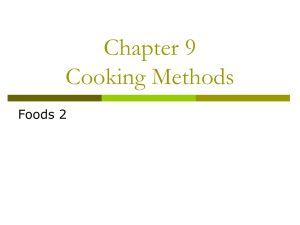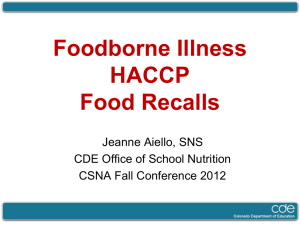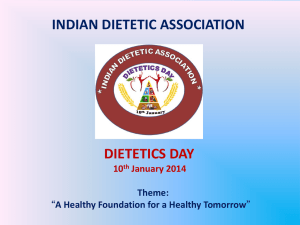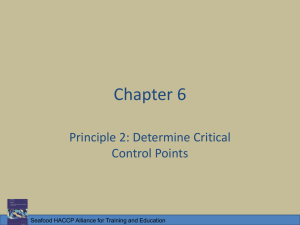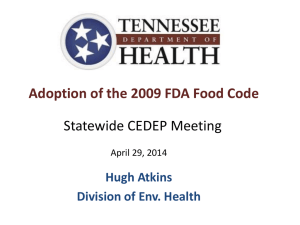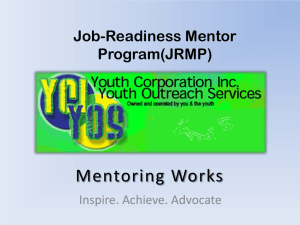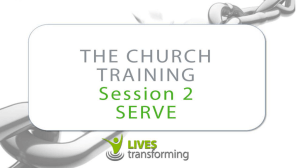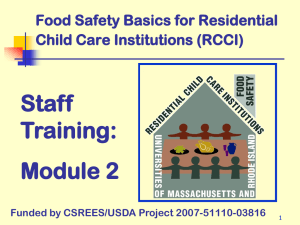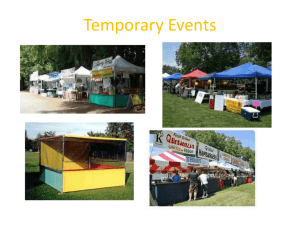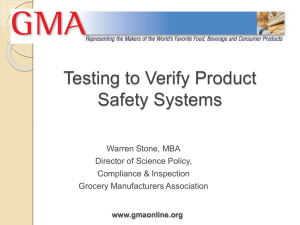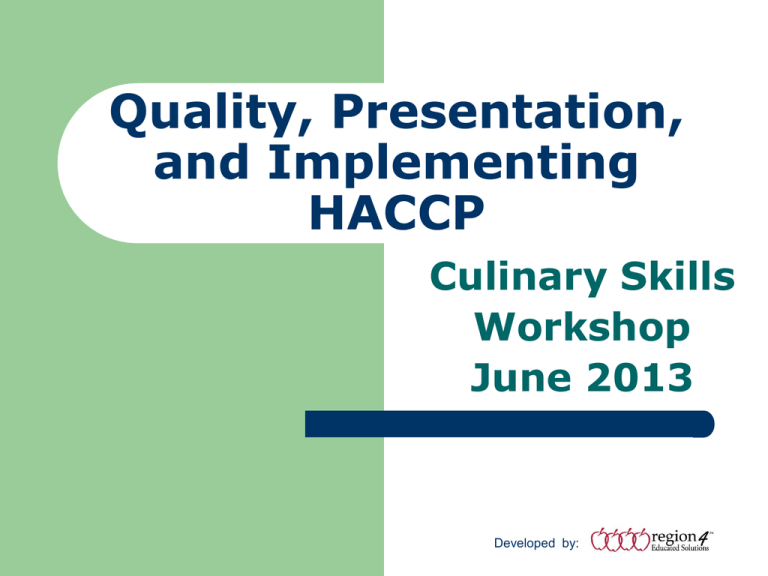
Quality, Presentation,
and Implementing
HACCP
Culinary Skills
Workshop
June 2013
Developed by:
Objectives
2
Explore quality standards
in delivering fresh,
appealing foods to
students.
Review HACCP principles
and tools to document
and verify your district’s
HACCP plan.
Objectives
3
Discuss the manager’s
role to ensure that safe,
quality meals are
provided to students.
Manager’s Role
Oversee
Program
Identify Training Needs
Monitor Compliance
Evaluate
Maintain Documentation
4
What does “quality” mean
to you?
5
EVALUATION FACTORS
6
Appearance
How the food should look
Texture or
Consistency
How the food should feel in the
mouth and how it cuts
Flavor
How the food tastes
Service
Temperature
The ideal temperature for serving the
food
Product Quality Factors
During Production
Standardized
recipes
Production equipment
Production schedules
Sanitation practices
Food production handling
techniques
7
Eight Keys to Success
Purchasing
Receiving
and Storage
Proper Handling
Preparation and Cooking
Eight Keys to Success
Serving
Line
Presentation
Proper Handling
Marketing
Purchasing
Commodity
dollars
What to process
– Who to process with
–
Frozen
vs. canned
vegetables
Purchase from HACCP
certified vendors
Receiving and Storage
Check
temperatures
immediately
Check dating
Check for any signs of
damage
Receiving and Storage
Store
products
appropriately
Practice FIFO
Proper Handling
Practice
proper techniques
for thawing according to
Serve Safe
In refrigeration at or below
41°
– Running water at or below
70°
–
Preparation and Cooking
For
all raw items follow
guideline set forth by Serve
Safe
Processed items follow the
manufacturer’s instructions
Preparation and Cooking
Develop
standards for
batch cooking
Ensure ovens are properly
calibrated
Enforce use of recipes
–
Standardized recipes
Proper Holding
Serve
–
–
–
Minimum temperature of 140°
Hot wells controls
Holding cabinets
Serve
–
hot foods hot
cold foods cold
Maximum temperature 41°
Serving
Proper
serving utensils
Storage and food
– Heat resistant handles
– Minimize bare hand
contact
–
Serving
Proper
personal
hygiene
–
–
No dangle earrings, fake
fingernails, polish, rings
Proper hand washing
Polite
and courteous
service
Line Presentation
Signage
All items should be labeled
– Clean easy to read menu
boards with pricing
–
Line Presentation
Use
garnishes when
possible
elevators
– risers
–
Keep
serving line clean and
free from debris
Marketing
Utilize
promotions
To create excitement
– To boost participation when
needed
– Enhance awareness of the
Child Nutrition Department
–
Marketing
Solicit
involvement from
brokers and manufacturers
Communicate upcoming
special events
Actions to Ensure Quality
23
Plan food production for just-intime service.
Review the recipe and organize
equipment and ingredients before
beginning production.
Always use the correct culinary
technique.
Deliver only the products that meet
quality standards.
Food Presentation
24
Objectives
Identify
key elements of
food presentation.
Evaluate the atmosphere of
the cafeteria serving line.
25
The Serving Line
How
does the line look?
The entire serving area
should look nice and
appealing, not just the
food.
26
The Serving Line
Use
pans that fit properly
into steam table wells.
Use appropriate serving
tools and utensils
27
5 Key Elements of
Presentation
COLOR
Shape
28
Colorful Serving Line
29
Colorful Serving Line
30
Colorful Serving Line
31
Color
32
Color: Preparation
Techniques
33
Texture
34
Texture Names
35
Grilled Chicken Strips
Mild Mozzarella
Cheese
Crisp Mixed Greens
Hearty Red Kidney
Beans
Creamy Dressing
Crunchy Baby Carrots
Tender Corn
Ripe Green Tip
Banana
Crusty Whole Wheat
Roll
Cold Chocolate Milk
Shapes: Food Variety
36
Shapes: Food Variety
37
Shapes: Food Variety
38
Simplicity
39
Height
40
Self-Serve Packaging
41
Balance
42
Presentation must be balanced
through the selection of food by
choosing complementary flavors,
seasonings, and food groups.
Food should be prepared using
different but complementary
cooking methods and arranging it
in an appetizing presentation.
Flow
43
The focal point is the necessary
starting point from which the flow
should begin.
The sense of flow will be stronger
with an interesting set up.
The customer should be led down
the line by pleasant displays of
food choices.
Atmosphere
44
The atmosphere of the serving area
and dining area influence customer
participation.
Take a Look at the
Cafeteria
45
Is it well lit?
Is the food inviting?
Is there adequate room to sit?
Do you have a smile on your face?
Are the decorations cheerful?
Do you show attention to detail?
Are customers happy when they
enter the cafeteria?
Take a Look Cont’d.
46
Is signage posted at or near the
beginning of the serving line identify
components of the reimbursable meal?
Does the serving line move quickly
and continuously?
Is the temperature of the room
comfortable?
Does your cafeteria convey a positive
atmosphere?
Why Implement HACCP?
To
ensure that the food
served to children is as
safe as possible.
Federal regulations
require schools to
have a HACCP Plan.
47
What is HACCP?
A
food safety system
that focuses on food.
48
What is HACCP?
H
A
C
C
P
49
hazard
analysis
critical
control
points
Hazard Analysis
Identification
of hazards
than can contaminate food.
50
Hazards
Physical
Chemical
Biological
51
Critical Control Points
Control
hazards through
critical control points.
Essential step in the food
flow to prevent, eliminate
or reduce a food safety
hazard.
52
Example
Hamburger
might have
harmful bacteria E.Coli.
Cooking to a hot enough
temperature will kill the
bacteria.
CCP is the cooking step.
53
Seven Principles
1. Identify Hazards
2. Identify Critical Control
Points
3. Establish Critical Limits
4. Establish Monitoring
Procedures
54
Seven Principles
5. Establish Corrective Actions
6. Establish Verification
Procedures
7. Establish Record-Keeping
Procedures
55
Advantages of HACCP
Improve
control of food
processes.
Help comply with
government regulations.
56
Advantages of HACCP
Provide continuous selfinspection and self
improvement.
Help with complaints and legal
action.
57
Why do you need to know
about food safety?
Foodborne illness occurs when a
person becomes ill from eating
food that contains a biological,
chemical, or physical hazard.
58
Why do you need to know
about food safety?
Foodborne outbreak occurs
when 2 or more people
experience the same illness after
eating the same food.
59
Why Risk It?
Developed by:
The Costs to Your District
are Great
Financial
Sick
loss
customers
Reputation Lawsuits
61
Actions Contributing to
Foodborne Illnesses
62
Holding food too long in
temperature zone (41oF to 135oF).
Not heating or cooking to proper
temperature.
Not cooling properly (to 70oF or
lower within 2 hours, and from
70oF to 41oF within 4 hours).
Actions Contributing to
Foodborne Illnesses
Not reheating properly (to at
least 165oF for 15 seconds
within 2 hours).
Poor personal hygiene.
Cross-contaminating
food.
63
The Process Approach
HACCP
principles are built
into the Process Approach.
64
Food Process Categories
1.
2.
3.
65
No Cook Process
Same Day Service Process
Complex Food Process
Temperature Danger Zone
Identify
the number of times
each menu item goes up
(heating) or comes down
(cooling) through the danger
zone (41 ºF to 135 ºF)
66
Control Point
Where
a hazard can be
controlled in the flow of
food
CP
67
Critical Control Point
Essential
step to prevent,
eliminate, or reduce a
hazard to an acceptable
level.
CCP
68
Control Points
CPs include:
Reheating
Serving
Preparing
Cooking
Receiving
69
Cooling
Holding
Storing
CCPs – Example
CCPs for raw hamburger patties
in a full-service kitchen
(hazard is harmful bacteria)
70
Receiving- not CCP
Storing- not CCP
Preparing- not CCP
Cooking- CCP
Holding – CCP
Serving – not CCP
Process # 1
No Cook Preparation
Measure to assure safety of
foods:
Employee health policy
Proper receiving and
storage procedures
71
Process # 1
No Cook Preparation
Measure to assure safety of
foods continued:
Temperature control
Handwashing
72
NO COOK Process Flow
Three-Bean Salad, Full-Service Kitchen
Canned ------Liquid/Dry---------Receive----------Fresh Vegetables
Beans
Ingredients
Dry (on shelf)-----------------------Store-----------Refrigerator
Refrigerator (day before prep)
Drain beans---Mix liquid/dry----Prepare-------Chop and add
Hold (in refrigerator)
Serve (cold)
73
Process # 2
Same Day Service Preparation
Measure to assure safety of
foods:
Temperature control
Cooking foods
Handwashing
74
Process # 2
Same Day Service Preparation
Measure to assure safety of
foods continued:
Employee health policy
Proper receiving and
storage procedures
75
SAME DAY SERVICE
Process Flow - Example
Oven Fried Chicken, Full-Service Kitchen
Frozen Chicken------------Receive---------Dry/Liquid Ingredients
Freezer----------------------Store----------------------Dry (on shelf)
Thaw in refrigerator-----Prepare------1. Drizzle oil over chicken
2. Dip chicken in seasoning bread
Cook
Hold (hot)
Serve (hot)
76
Process # 3
Complex Food Preparation
Measure to assure safety of
foods:
Temperature control
Cooking foods
Cooling foods
Reheating foods
77
Process # 3
Complex Food Preparation
Measure to assure safety of
foods continued:
Handwashing
Employee health policy
Proper receiving and
storage procedures
78
COMPLEX Process Flow
Chili Con Carne, Full Service Kitchen
Raw Ground Beef--------Receive------Fresh---------Canned-----------Dry
Vegetables
Vegetables
Ingredients
Freezer--------------------Store------Refrigerator---------Dry (on shelf)
1. Thaw in Refrigerator-----Prepare---------Chop------Add to Ground Beef
2. Brown Ground Beef and Drain
Cook
79
COMPLEX Process Flow
Chili Con Carne, Full Service Kitchen (con’t)
Cool/store
Reheat
Hold (hot)
Serve (hot)
80
Critical Limits
Upper
boundary of safety.
Time and temperature.
Ex.- baked chicken cooked
to internal 165° for at least
15 seconds.
81
Standard Operating
Procedures (SOP)
SOPs will describe how to
handle foods identified by each
process.
SOPs will instruct personnel on
proper food safety procedures
at every stage of food
preparation and service.
82
Monitoring
Monitor
to make sure food
safety practices are done
properly.
Who will monitor
– How
– When
–
83
Corrective Action
Recognize
when there is a
problem.
Have a plan for corrections.
Train employees.
Document.
84
Verification
Procedures
Frequency
Documentation
Weekly
85
checklist
Recordkeeping
Compliance
Actions
taken
Documents that you are
serving safe food each day
86
REMEMBER
If it has not been
documented, it has
not been done!
87
Records
District HACCP Plan
Employee training logs
SOPs
Monitoring logs
Corrective actions
Calibration logs
Receiving logs
88
Health Inspections
HACCP
Plan review
Monitoring logs
Calibration logs
Weekly checklists
89
Success of Your Food
Safety Program
Provide
on-going training.
Review food safety
principles including SOPs
on a regular basis.
Require employees to
attend food safety training.
90
Success of Your Food
Safety Program, continued
Maintain
training and
attendance records.
Hold school nutrition
managers responsible for
maintaining employee
training standards.
91
“In accordance with Federal law and U.S.
Department of Agriculture policy, this
institution is prohibited from discriminating on
the basis or race, color, national origin, sex,
age, or disability. To file a complaint of
discrimination, write USDA, Director, Office of
Civil Rights, 1400 Independence Avenue, SW,
Washington, D.C. 20250-9410 or call (800)
795-3272 or (202) 720-6382 (TTY). USDA is an
equal opportunity provider and employer.”
Our services are provided through the Texas
Department of Agriculture’s Food and Nutrition
programs funded by the U.S. Department of
Agriculture, Food & Nutrition Service
92

